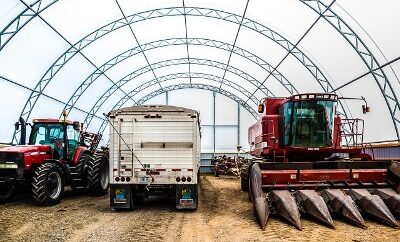Equipment Storage Matters: How to Prevent Corrosion On Your Snow Equipment
by Admin | Jan 18, 2019

When snow season is in full effect it this means pulling out the necessary equipment. According to the Automobile Protection Agency (APA) snow machinery and equipment experiences deterioration from corrosion after about five years if not in a proper equipment storage structure, resulting in increased costs for maintenance and repair. However, there are a few simple things you can do at home to prevent corrosion on your valuable winter equipment.
Proactive Prevention
Even after the first heavy snow and temperatures have dropped, you should still give your snow vehicle and equipment a bath. Washing the vehicles and equipment throughout the season keeps salt build-up at bay.
During washing, check for early signs of rust that might already be spreading. If you find some rust, wash the area thoroughly, sand the rust off, and repaint the area. This gives the metal a protective coat. After washing, grease up all moving contact points to ensure they are well lubricated.
Before and after each use of your snow equipment of vehicle, check any electrical connections and make sure they are not corroding. If you see some early corrosion spots, disconnect the battery and remove the terminal or plug that needs to be inspected, then use a small wire brush to clean off the corrosion. Once complete, add dielectric grease to all terminals before you plug them back in to help prevent salt, water, and dirt from causing future corrosion.
Corrosion-Prevention Products
Oil products have been used on snow machinery for years and penetrates the tiniest crevices while neutralizing the harmful effects of rust. To get the best results from using oils, machines should be oiled yearly or as required. Be sure to select products that are specially designed for corrosion control. More effective oil products will be thinner, offering a better penetrating ability for harder-to-reach areas.
Wax and tar products can be used depending on the type of snow equipment, tool, or machinery you use. Make sure that the machinery is dry if using these types of products, and don’t let these types of products sit on water as they could counteract the corrosion-prevention effects. While wax and tar products offer great coverage of your snow vehicle or equipment that withstands the elements, there are some key disadvantages to keep in mind. For example, wax and tar products do not penetrate hard-to-reach areas of the vehicles, and they have a tendency to dry out and crack, in turn allowing moisture and salt to become trapped and accelerate corrosion. Keep these points in mind if opting for wax or tar products.
Equipment Storage Structure
Snow equipment and vehicles should be stored in a cool, dry, covered equipment storage structure, on pavement, gravel, blocks, or on top of a storage container. The equipment storage structure should be covered in such a way that isn’t too tight so to reduce the collection of condensation build-up which can end up damaging your machinery.
Fabric structures are an ideal solution for snow equipment and vehicle storage as the natural breathability of the fabric covers creates a climate-controlled environment. Calhoun’s fabric equipment storage structure are further protected from any possible corrosion due to the hot-dip galvanized steel framework. To learn more about how Calhoun’s fabric buildings can help you safely store away your snow machinery this winter, contact a Calhoun representative.

